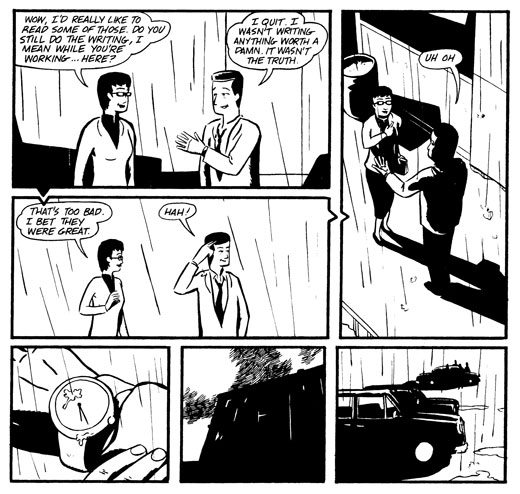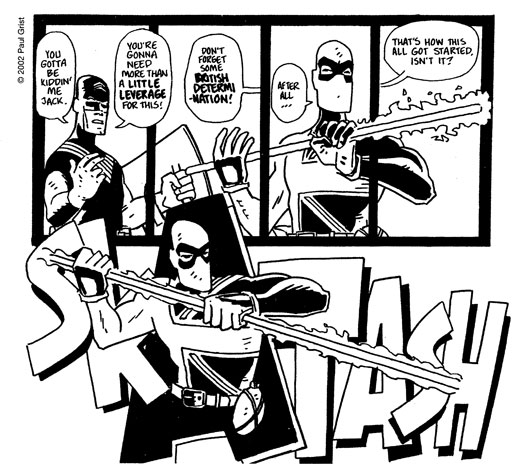Reporter
Dylan Williams
Self-published

Lamentably, most of the mini-comics I read don't stay with me long after I read them. Most of their stories - and here I don't mean to include the more anecdotal, gag, or strip-format minis - run about ten pages long and do not reach, in that short spell, a narrative or thematic complexity. Dylan Williams' Reporter series is an exception to this norm. Reporter is thoughtful and unusual, thematically complex and reflective of the process of writing. Reporter also tells a good, albeit ambitious, story.
To give a sense of the narrative, I'd like to go into a bit of detail about the first issue of the series. Reporter #1 kicks off the story of two very different writers, Adam and Ivar, living in the town of Willoughby. Period-fiction writer Adam sits across the table from "natural history" diarist lvar (who aspires to record everything) at a local diner. Adam is called outside by his "muse," a bandaged character dressed in Mafioso suit and hat, who strongly suggests that he pay attention to the immanence of death. Adam returns to the table and tells Ivar of his predicament: he owes his muse for a story idea he solicited. The story, which Adam relates to Ivar, is a metaphor for writing about two kids' discovery of an underwater stone giant. Reporter #1 ends with Adam's resolution to return the story idea and to start telling the truth in his writing.
In Reporter #2 Ivar's dedication to his project of recording everything abbreviates a developing relationship with a young ghost named Felicia Frame, who herself has "baggage" that interferes in the affair. The issue ends with Ivar leaving Willoughby on a bus, bound to continue his work in the next town. In Reporter #3 Adam, in his quest to tell the truth, has become an aspiring reporter stuck doing the more lowly jobs at the local newspaper. While working over the weekend he is interrupted by four robbers who are fleeing a heist. They intend to take him hostage, but he gives them the slip. Adam's run-in with the criminals turns out to be a stroke of luck as it provides his claim to writing the newspaper story about the whole event. This story - it has the feeling of a story within a story, as if it may be an intrusion of Adam's “untruthful” imagination - is another of Williams' ways of suggesting that weird, extraordinary forces are at work in life, interfering in different ways, and that these may even be given credit for "making life interesting."
Aside from the more anomalous forces at work, the past plays a leading role in Reporter. The past, represented by ghosts, flashbacks, and the abrupt return of old "skeletons," keeps popping up and manipulating the sequence of events. This experimenting with the time is perhaps most self-consciously explored in a three story progression in the Reporter Short Story Collection which has a sequence of events happen in reverse time. In other words, the B is given before the A, and everything that goes on in between, the bulk of each story, is revealed as a very odd series of means to all end. If there is a point to all this manipulation of time, it's that one never knows when the past will come back a'haunting or exactly how any situation will give rise to future events.
Another theme at play in Williams work has to do with the reflective process of writing. There are two different versions of truth for Adam and Ivar. Adam is two-sided, wedded to reportage in his job, but strongly inclined to flights of imagination, while Ivar would like to record - to simply get down everything that is going on around him. One wonders if their habits in fact become crossed, in a way, being that Ivar's "natural history" notebook surely contains an account of a ghost and Adam's wild imagination was, perhaps, surpassed in extraordinariness by the real events in #3.
When I first picked up Reporter #1 I was given to the idea that Williams' artistic style was nothing all that interesting, nothing all that unusual. However, that was before I realized that there is a definite function to the simplicity of Williams' renderings. Williams' simple artistic style juxtaposes nicely with the narrative complexities in the story he is telling. The main characters in the narrative arc simply, consistently drawn and made to look like the epitome of who they are. Adam looks highly plausible as a young adult writer, simply dressed yet expressive. Ivar looks like what you would imagine a dweebie fifteen year old introvert intellectual would look like: always dressed in a suit and bow-tie and is reserved both in terms of facial and bodily expression. The more fantastic characters that they come into contact with, the same fantastic characters that influence their lives so much, are simply drawn yet aren't so stereotypical. When I think of a muse, an art-nouveau picture of a beautiful woman pops into my head - a far cry from Williams' bandaged marauders. Ivar’s love interest, Felicia Frame, hardly fits with the popular image of a typical ghost in style or in manner. She is about the least scary and most "everyday human" apparition in spook history. What I find so interesting - almost eerie - is that these fantastic characters are made plausible in that they fit almost seamlessly into the narrative. It is as though Adam, Ivar, and the few other realistic character are pausing all the time just long enough to remark "hmm, odd" as though they themselves recognize the improbability of these characters.
Aside from these general tendencies in Williams' Reporter series, there are a few very interesting artistic tools which he employs. He builds directional arrows right into the panels so that they distort the borders. Flashback scenes, which are particularly abundant in the short story collection are rendered with either charcoal or very soft graphite while the present time story is rendered in sharp inked lines. In terms of narrative features, Williams based the story in number two on David Lean's A Brief Encounter and got the death threat scene in number one from Jack Nicholson's script for the film Flight to Fury.
Certainly, Williams earned the Xeric Grant that helped make Reporter #3, including its beautiful cover, possible. His artistic and narrative styles are extremely complimentary and he has a good feel for dialogue. Though Reporter is rife with seemingly fantastic characters and situations, overall it has a very real feel to it. There is, however, a plot lurking in the background - involving a stolen antique - that threatens to unify the related situations into one grand, conspiracy-theory-informed plot. I worry that the development of this plot will push Reporter away from its realistic strangeness into epic blockbuster, though all I can do at this point is wonder and eagerly await Reporter #4.
Flora Worley

